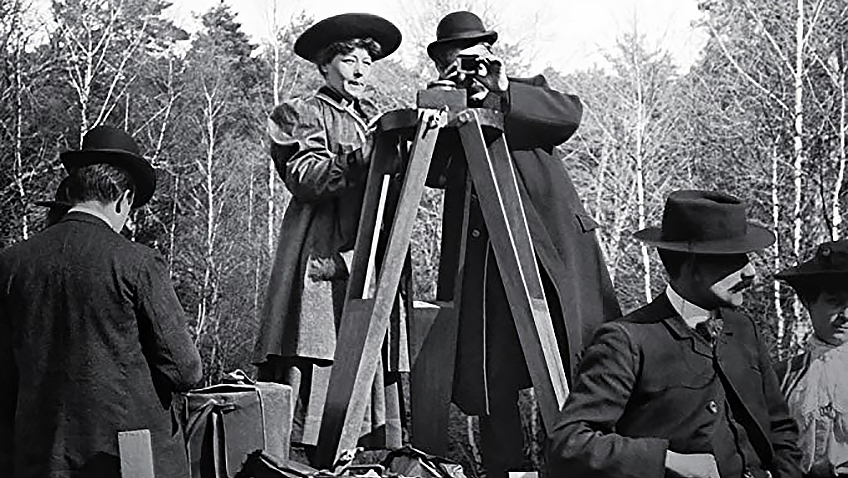Joyce Glasser reviews Be Natural: The Untold Story of Alice Guy-Blaché (January 17, 2020), Cert. PG, 102 min.
It is both ironic and completely expected, that the #MeToo movement and the reckoning of Harvey has released a revisionist history of the role of women in the film industry. In a fascinating article in the New Yorker Magazine, entitled Out of Frame, Margaret Talbot, discussing new books and research on the early female pioneers in the film industry contends that they ‘became victims of their own success.’ Once the hardware problem of projecting images was solved (by men) the women who got in early thrived as equals because the industry ‘had not yet locked in a strict division of labour by gender.’ Now, in an informative, if hard-to-digest whirlwind biopic, co- writer (with Joan Simon) and producer Pamela B. Green gives us the eventful story of Alice Guy-Blaché, arguably the world’s first female filmmaker and first narrative filmmaker.
It is 1895, and Alice Guy, born in a Parisian suburb 22 years earlier, is the recently appointed secretary to Léon Gaumont, a partner in a camera factory and photographic supplies company. Guy, pretty, ambitious and clever, learned everything she could about the various cameras in stock, and made excellent contacts. On March 22, Guy is thrilled to accompany her boss to August and Louis Lumière’s first demonstration of film projection, but all Gaumont can see is defeat: the brothers had beat their closest rivals, Edison and Gaumont.
Where Gaumont saw defeat, Alice saw opportunity. Yes, the film projection was exciting, but the film itself was a simple, drab shot of workers leaving the Lumière factory in Lyon, nothing more than a demonstration piece to sell the camera. Guy asked Gaumont if she could try her hand, and the result was La fée aux choux (The Cabbage Fairy) of 1896, arguably the world’s first narrative film. Written, directed, edited, hand-painted and starring Alice Guy (who made her own costumes), the film had a decidedly female orientation: A fairy skips through a cabbage plot magically drawing babies out of the plants.
It was a smash hit, and the first of some 1,000 films she writes, directs and edits for Gaumont (and later, for her own company) inventing astonishingly modern story lines and devising increasingly sophisticated techniques such as split screens, masking, double exposure, hand tinting, close-ups, running film backward, and pre-recorded sound using Gaumont’s Chronophone system, to bring her stories to life and keep her audiences growing.
From 1886 until 1906 Guy was Gaumont’s head of production and much more, as she continued to write, direct and edit as well as produce. And she was competing with men like the Lumière Brothers and Méliès in churning out dance and travel films. But Guy soon made her own inroads, making films about child abuse, planned parenthood, pregnancy, immigration and female empowerment. Her films with children were particularly endearing and often very funny, and she might also lay claim to be the world’s first comic director. ‘The Drunken Mattress’ of 1906 is slapstick, and then there’s The Sticky Woman’. A man can hardly contain himself watching a woman licking stamps until ultimately the two get stuck together.
Then Gaumont recruited an American, Herbert Blaché, as a salesman and Guy and Blaché, apparently thrown together, fell in love. In 1907, after making a Life of Christ with 300 extras, Alice married Herbert and accompanied him to New York where Herbert had been appointed Gaumont’s Head of US Production.
By 1910 Herbert and Guy-Blaché had established the Solax Company in Flushing, Queens and then in Fort Lee, New Jersey where it became the most successful pre-Hollywood production company in America. Although husband and wife worked side by side, he production manager and cinematographer, she as artistic director and director, Herbert was an aspiring director. Guy-Blaché had a sign in her office in Fort Lee: ‘Be Natural’ and in 1914 Blaché wrote, ‘There is nothing connected with the staging of a motion picture that a woman cannot do as easily as a man…’
This fairy tale does not have a happy ending as you will discover and history has not been kind either. Since the industry had no use for old films (there were no ancillary markets, the nitrate was too inflammatory to store and new films were considered better than the old) most were destroyed, along with the credits. Male film historians credited male directors with her films and years later, female historians and critics did not look for evidence of female participation as they assumed there was none. Gaumont’s reluctance to remember Guy’s contribution was intentional.
Concerned with her legacy, in the 1940s Guy-Blaché wrote her memoirs in French, and some ten years later they were translated, but could not find a publisher. As well as archival footage, Green includes touching interviews with the elderly Guy-Blaché as she spends the rest of her life (usually with her only daughter, Simone, with whom she lived) trying to track down her work and secure her place in history. Green has also been searching and has succeeded in locating photos and letters that relatives had stuffed into boxes and stored away in garages and basements.
In 1953, Guy-Blaché was awarded the Légion d’honneur, and in 1957, she was honoured in by the Cinématheque Française, but the press, perhaps as ignorant and disinterested as the public, and preoccupied with the emergence of French New Wave, failed to take notice.
Margaret Talbot’s article shows that Guy-Blaché was hardly alone among women who have been erased from film history. But Guy-Blaché’s pioneering achievements make her unique. Work is underway to restore this extraordinary woman’s place in history, and films like this will certainly help. But Green’s documentary, packed with flow charts, maps, diagrams and facts, informs and overwhelms at the same time. She has a tendency to go off on tangents, beginning a flow chart, for instance, and seldom returning to the starting point. While the film could be enhanced by a tighter structure, it is a challenge to keep up with the pace of Jodie Foster’s enthusiastic narration.
You can watch the film trailer here:





